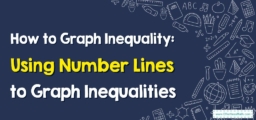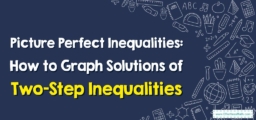How to Graph Solutions to One-step and Two-step Linear Inequalities
Dive into the mysterious world of linear inequalities, where the solutions often lie in a vast stretch of the number line rather than a single, fixed point. This journey will explore one-step and two-step inequalities, inviting you to master the nuances of their graphical representations.

Step-by-Step Guide to Graphing Solutions to One-step and Two-step Linear Inequalities
Here is a step-by-step guide to graphing solutions to one-step and two-step linear inequalities:
Step 1: Understand the Terrain: Basic Inequalities Overview
- Less than (\(<\)): Think of a hungry alligator, always eager to chomp the smaller number.
- Greater than (\(>\)): The reverse. The alligator now wants the bigger number.
- Less than or equal to (\(≤\)): Here, the alligator doesn’t mind if it’s exactly equal or just a tad smaller.
- Greater than or equal to (\(≥\)): Big or just the same, both are good enough!
Step 2: Setting the Stage: Drawing a Number Line
- Take a ruler or a straightedge.
- Sketch a horizontal line, which will represent our number line.
- Evenly space and mark numbers on this line. For instance, from \(-10\) to \(10\).
Step 3: One-Step Inequalities: Baby Steps to Mastery
a) Isolate the Variable
i) If the inequality is \(x>5\), then \(x\) is already isolated.
ii) For an inequality like \(x+4<7\), subtract \(4\) from each side to get\(x<3\).
b) Graph the Solution
i) For strict inequalities like \(x<3\) or \(x>5\):
- Find the number on the number line.
- Make an open circle on it, indicating the value is not included.
- Draw an arrow in the direction of the solution. For \(x<3\), the arrow will point to the left.
ii) For inclusive inequalities like \(x≤3\) or \(x≥5\):
- Find the number.
- Fill in a solid circle, indicating that this value is part of the solution.
- Again, draw an arrow toward the solution side.
Step 4: Two-Step Inequalities: Double the Fun, Double the Challenge
a) Isolate the Variable
i) For an inequality like \(2x−3>7\):
- Start by adding \(3\) to each side: \(2x>10\).
- Then, divide each side by \(2\): \(x>5\).
b) Graph the Solution
i) Much like one-step inequalities, locate the number on the line.
ii) Decide if you need an open or a solid circle based on the strictness or inclusiveness of the inequality.
iii) Draw the arrow pointing towards the solution’s direction.
Step 5: Celebrate the Complexity: Compound Inequalities
Sometimes, you might find a beast like \(3<x≤8\). Here, \(x\) is trapped between two numbers.
- Graph the two numbers. One will have an open circle \((3)\) and the other, a filled one \((8)\).
- Connect them with a line or segment to show \(x\) can be any number in between.
Step 6: Conclusion: Embrace the Dance of Inequalities
Understanding and graphing linear inequalities is like a dance of logic and intuition. With time and practice, you’ll find the rhythm and soon be swirling and twirling through even the most intricate inequalities with grace and precision!
Related to This Article
More math articles
- How to Find the Polar Form of Complex Numbers?
- 8th Grade AZMerit Math Worksheets: FREE & Printable
- Decoding Data: How to Identify Representative, Random, and Biased Samples
- How to Find Mean Absolute Deviation?
- How to Solve Linear Equations in Two Variables?
- What Are the Applications of Inverse Trigonometric Functions?
- Top 10 4th Grade Common Core Math Practice Questions
- How to Write the Equation of Parabola?
- SSAT Upper-Level Math Worksheets: FREE & Printable
- CBEST Math Practice Test Questions













What people say about "How to Graph Solutions to One-step and Two-step Linear Inequalities - Effortless Math: We Help Students Learn to LOVE Mathematics"?
No one replied yet.